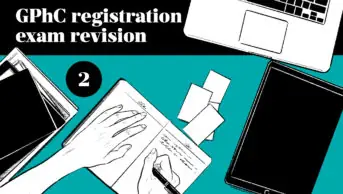
Shutterstock.com
Foundation trainees who complete their placements in hospital were more likely to pass the first sitting of the registration assessment, compared with students undertaking their placements in a community setting, according to an analysis of pass rate data between 2016 and 2024.
The study, published in the International Journal of Pharmacy Practice on 3 December 2024, looked at factors that impact pass rates for the registration exam, including the school of pharmacy students had attended and preregistration placement type.
Between 2016 and 2024, the authors said that students were more likely to pass — and obtain higher scores — if they completed their placement in hospital, compared with those who completed their placement in community (Fisher’s exact test, two-tailed, P<0.0001).
They said that the trend is seen irrespective of which school of pharmacy the trainee attended.
The authors also found that pass rates among trainees from different pharmacy schools ranged across the years.
The highest pass rate was 100% (n=114/114), among trainees from one university, identified only as “MPharm programme 2” in 2012. The lowest, recorded in 2019, was 7.9% (n=34/71) from “MPharm programme 28”.
The report also said that there was no correlation between the number of students that graduated from a particular MPharm programme and the pass rate.
“Other variables, such as protected characteristics like ethnicity and socio-economics, may play crucial roles, necessitating further investigation to fully understand their impact,” the paper noted.
“The GPhC [General Pharmaceutical Council] data do not provide insight into individual candidates, which includes demographic characteristics.
“This makes it difficult to tease out the effects of ethnicity from the other variables that are thought to affect performance,” it added.
The authors concluded: “We should seek to explore ways to improve or standardise training in community pharmacy environments.
“There are undoubtedly good examples of high-quality training, but we need to understand what that looks like.”
“Schools of pharmacy should work with the GPhC to produce more detailed data which link an individual’s demographic characteristics at entrance, their progression through the programme and upon exit to enable teams to properly track and analyse the impact of protected characteristics and socio-economic differences,” they added.
GPhC meeting papers, published in September 2024, reported that the pass rate for the first sitting of the registration exam in June 2024 was 89% among students who completed their placement in hospital, compared with 68% of students who completed it in a community setting.
The highest pass rate was among those who did their training in a combined hospital/GP setting, with a pass rate of 93%.
The overall pass rate for the June 2024 exam was 75% — the lowest in five years, down two percentage points from the 77% pass rate for the summer assessment held in 2023.
Oisín Kavanagh, senior lecturer at Newcastle School of Pharmacy and one of the authors of the study, said: “In the past, the GPhC has published data each year on student performance, but until now we have yet to have an exploration of the dataset across all the years. This has enabled us to identify quite dramatic differences in student performance, which appear to be sustained over long periods of time.”
He added that the pass rate gap “is present for both the best and worst students in what we define as ‘Group A institutions’ (the best MPharm programmes with respect to passing rates) and ‘Group L ([institutions’], which do not have such high passing rates)”.
“This is of particular interest because some experts assume that the best students will always perform well, no matter where they are educated and trained,” he said.
In terms of the gap between community and hospital, Kavanagh said: “I was trained in community pharmacy by a brilliant pharmacist and his team”, but added that “when I sat the registration exam, I remember the first question asked which drugs would need titration in renal failure. This is simply something that you do not encounter in community pharmacy”.
“I wonder, does the performance gap relate to the types of questions in the GPhC exam (which might favour hospital candidates), as opposed to true assessment of the candidates’ competence? How do we expose students across all sectors to the same clinical experiences?” he asked.
You may also be interested in

Preparing for the GPhC registration exams: how to revise learning outcomes relating to clinical knowledge and therapeutic approaches

Preparing for the GPhC registration exams: how to approach learning outcomes relating to professional practice
